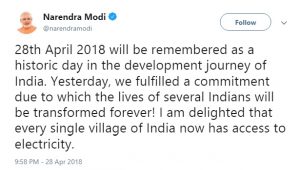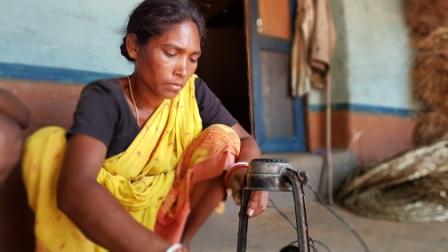Bhubaneswar: In the last week of April 2018, Prime Minister Narendra Modi had claimed on his Twitter handle that every single village in India has been electrified and termed it a historic day in the development of the country. However, almost a year after his claim, ground realities in Odisha beg to differ.
Besides the PM’s claim, in a response to the Lok Sabha January 3 this year (unstarred question 3721), the Union government said that Odisha achieved 100 per cent rural electrification under the Deen Dayal Upadhaya Gram Jyoti Yojana (DDUGJY) April 28, 2018. The government further said that under the its Soubhagya scheme, household-level electrification in Odisha was 100% by the end of December 2018.
However, ground realities in different parts of the state speak against the half-baked truths of the Centre – its claim of universal penetration of electricity into the villages and households of Odisha.
According to Anadu Majhi, a resident of Besarpani village in Samakhunta Block of Mayurbhanj district, even seven decades after Independence and after five years of the Modi government, the village is yet to get electricity connection.

Talking to Orissa POST, Majhi said, “We live on the periphery of Similipal forest reserve and are often vulnerable to animal attacks. They try to intrude into our village as soon as darkness engulfs our area. We hardly venture out in the night fearing animal attacks. Electricity has totally eluded our village till now.”
Majhi went on to say that there are around 60 households in the village and they are clueless about electricity. The villagers claim that on several occasions, government officials have assured to help them but nothing has changed till now. As of date, only electric poles have been erected in the in the locality. Now, the villagers have started disbelieving the government officials and their fake claims.
Similar is the tale of other areas in the state. At several other places, the process of electrification has been languishing, while villagers are rallying around local electric offices to demand their rights. In Kusia and Kanpura panchayats of Kamakyanagar block of Dhenkanal district, several villagers are now tired of raising their demand for electricity.
“We are running from pillar to post to get electricity for our village. An electric pole was installed eight months back, but electricity is yet to reach us. When we ask the local officers they say our village has been left out due to lack of transformers,” said Chittaranjan Sethi, sarpanch of Kanpura panchayat. He also added that while the village has not got electricity, placards of electricity scheme under rural electrification projects were placed on most of the houses there.
Similarly, it is reported that around 200 villages in Kandhamal district are yet to be electrified. Several areas in the district such as Arapad and Kendusahi villages of Phulbani block are still awaiting the tall claims of the Modi government to be translated into action.
“Several materials like poles and wires have been stacked in our villages but we are still waiting to see our houses lit up. We have heard about the claims of 100 per cent electrification, but are yet to see it turning into a reality,” said Ajit Manjhi, sarpanch of Chancher panchayat in Kalahandi district. This panchayat in Bhawanipatna block comprises villages like Dharawata, Otgarla and Talapipili which are still deprived of electricity.
According to data available from the Ministry of Power, Odisha was reported to have achieved 100 per cent electrification April 28, 2018 under the Deen Dayal Upadhaya Gram Jyoti Yojana (DDUGJY). Under the NDA government, the erstwhile Rajiv Gandhi Grameen Vidyutikaran Yojana (RGGVY) of the UPA government was renamed as DDUGJY and re-launched with the same guidelines and procedures.
The renamed rural electrification project of the NDA government claimed to have identified 3,860 un-electrified villages in Odisha and electrified 3,281 villages, while 579 villages were declared ‘un-inhabitated’. Last year, the Central government claimed 100 per cent rural electrification under the DDUGJY, which was meant only for electrification of ‘rural’ areas. The beneficiaries were identified based on the Socio-Economic Caste Census of 2011.
On the other side, the Centre launched a new scheme christened Saubhagya Yojana to ensure universal household-level electrification in rural as well as urban areas and ensured providing free connections to BPL families. Data available from the ministry claims that since the launch of the scheme October 11, 2017, it covered 23,99,186 households in Odisha till December 31, 2018. On that day, the Centre claimed that 100 per cent household-level electrification in Odisha.
When asked to comment on the discrepancies in the Centre’s 100 per cent claim and the ground reality of non-coverage, a Deputy Secretary in the state Department of Energy said that there are many households in Odisha which are still deprived of electricity for several reasons including fragmentation of houses, construction of new houses and discovery of new un-electrified houses during field visits among others. He claimed that the electrification is an ongoing process and Odisha is yet to get 100 per cent electrification.
